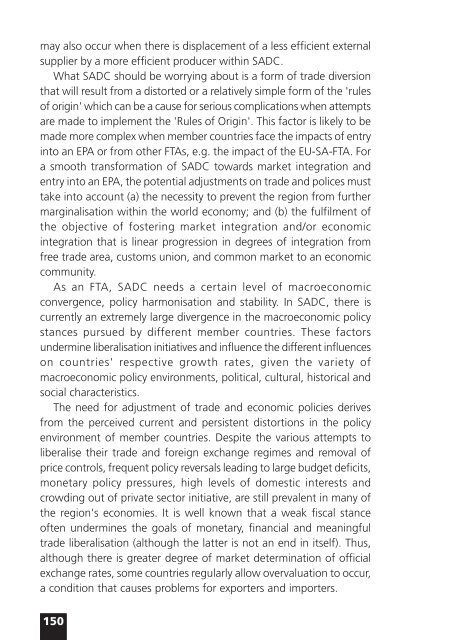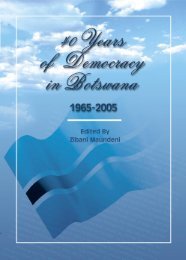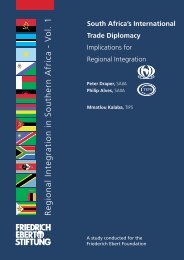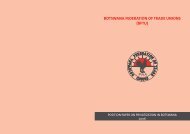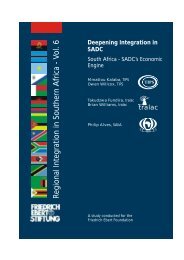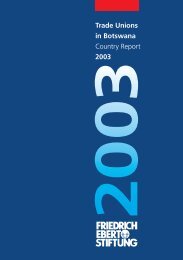Deepening Integration in SADC - Fes-botswana.org
Deepening Integration in SADC - Fes-botswana.org
Deepening Integration in SADC - Fes-botswana.org
Create successful ePaper yourself
Turn your PDF publications into a flip-book with our unique Google optimized e-Paper software.
may also occur when there is displacement of a less efficient external<br />
supplier by a more efficient producer with<strong>in</strong> <strong>SADC</strong>.<br />
What <strong>SADC</strong> should be worry<strong>in</strong>g about is a form of trade diversion<br />
that will result from a distorted or a relatively simple form of the 'rules<br />
of orig<strong>in</strong>' which can be a cause for serious complications when attempts<br />
are made to implement the 'Rules of Orig<strong>in</strong>'. This factor is likely to be<br />
made more complex when member countries face the impacts of entry<br />
<strong>in</strong>to an EPA or from other FTAs, e.g. the impact of the EU-SA-FTA. For<br />
a smooth transformation of <strong>SADC</strong> towards market <strong>in</strong>tegration and<br />
entry <strong>in</strong>to an EPA, the potential adjustments on trade and polices must<br />
take <strong>in</strong>to account (a) the necessity to prevent the region from further<br />
marg<strong>in</strong>alisation with<strong>in</strong> the world economy; and (b) the fulfilment of<br />
the objective of foster<strong>in</strong>g market <strong>in</strong>tegration and/or economic<br />
<strong>in</strong>tegration that is l<strong>in</strong>ear progression <strong>in</strong> degrees of <strong>in</strong>tegration from<br />
free trade area, customs union, and common market to an economic<br />
community.<br />
As an FTA, <strong>SADC</strong> needs a certa<strong>in</strong> level of macroeconomic<br />
convergence, policy harmonisation and stability. In <strong>SADC</strong>, there is<br />
currently an extremely large divergence <strong>in</strong> the macroeconomic policy<br />
stances pursued by different member countries. These factors<br />
underm<strong>in</strong>e liberalisation <strong>in</strong>itiatives and <strong>in</strong>fluence the different <strong>in</strong>fluences<br />
on countries' respective growth rates, given the variety of<br />
macroeconomic policy environments, political, cultural, historical and<br />
social characteristics.<br />
The need for adjustment of trade and economic policies derives<br />
from the perceived current and persistent distortions <strong>in</strong> the policy<br />
environment of member countries. Despite the various attempts to<br />
liberalise their trade and foreign exchange regimes and removal of<br />
price controls, frequent policy reversals lead<strong>in</strong>g to large budget deficits,<br />
monetary policy pressures, high levels of domestic <strong>in</strong>terests and<br />
crowd<strong>in</strong>g out of private sector <strong>in</strong>itiative, are still prevalent <strong>in</strong> many of<br />
the region's economies. It is well known that a weak fiscal stance<br />
often underm<strong>in</strong>es the goals of monetary, f<strong>in</strong>ancial and mean<strong>in</strong>gful<br />
trade liberalisation (although the latter is not an end <strong>in</strong> itself). Thus,<br />
although there is greater degree of market determ<strong>in</strong>ation of official<br />
exchange rates, some countries regularly allow overvaluation to occur,<br />
a condition that causes problems for exporters and importers.<br />
150


